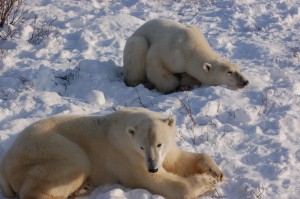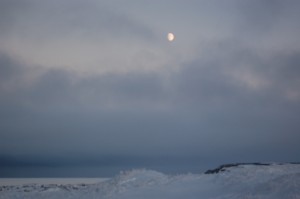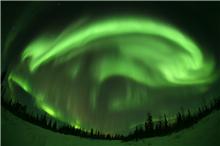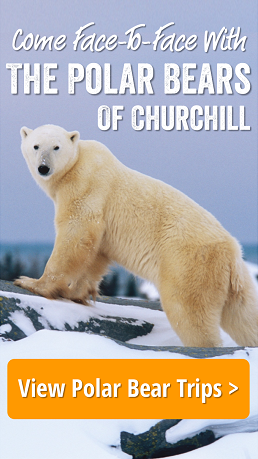Beluga’s Winter up North
Churchill has seen a little warming trend with temperatures just above the freezing mark. Melting snow and fear of an early break-up have fueled the global -warming theories. Fortunately the current temperature is -9C with light snow and the extended forecast for the week is colder temperatures in the -20s C …back to seasonally cold weather. The longer the ice lasts into Spring the better…especially with the l;ate freeze last Fall. Numerous sows and cubs as well as their tracks have been seen crossing the land between Wapusk National Park and the Hudson Bay as the family units make their way onto the ice to hunt seals. We will be watching the weather intently over the next two months…stay posted!
Meanwhile up North…while the bears are doing their thing on the ice encrusted Hudson Bay, another marine mammal literally lies in wait for the break-up.. allowing them to migrate South for the Summer. I know it seems a little backward in the migration process.
At the outset of my Arctic Summer guiding career about 14 years ago, I could not grasp why beluga whales migrated North at the end of the late Summer. Believing that as you traveled further North you would encounter colder temperatures and more ice -pack in any body of water, I was constantly questioning the beluga’s decision making. Should they not be searching out a ” Southwest passage” of sorts…a hidden estuary or river system that would land them in the Caribbean for the Winter? And how, at any rate, could they survive the Winter up North when everything is frozen and they need to have access to open water to breathe every 10-12 minutes at the very least.
Well, we all know about open “leads” in the pack ice…the water lines that appear when ice pans or floes break apart due to currents and winds. Most of these leads are unpredictable and close up almost as fast as they appear. For beluga whales to Winter over in a certain area they need that predictable open water. Enter the Hudson Straits. As you can see on the map, the straits are pretty far northeast of the Hudson Bay. When one sees how the lower Hudson Bay as well as the Churchill River freezes up solid, it’s natural to assume anywhere North of 58.44 degrees latitude would as well. Well most of the open water does but there’s a current system in the Hudson Straits that allows for a wide expanse of continually open -water. This area is known as a “polyna”, a Russian word describing an enclosed area of open water surrounded by ice.
Researchers have found polynas in the Hudson Straits and have tracked large pods of Hudson Bay beluga whales to these sights. They still have not discovered exact evidence as to why the whales migrate to this location. One theory is for the whales to escape predation by killer whales though their isolation in the ice surrounded polynas increases their chances of polar bear predation. Another thought is rich Arctic cod and char fishing grounds. However, many theories still point to the fact that this current influenced, open water is a predictable Winter respite where the whales use their fine tuned echolocation capabilities to dive below ice and return to the open expanse of water. Continuing research should provide more answers.
Click here to see ice formation in the Hudson Straits.
When you arrive on the Environment Canada page, scroll down to Hudson Straits and click. You will see the open polyna in the straits. Browse through the other areas that are current and you can see ice depths and coverage.








